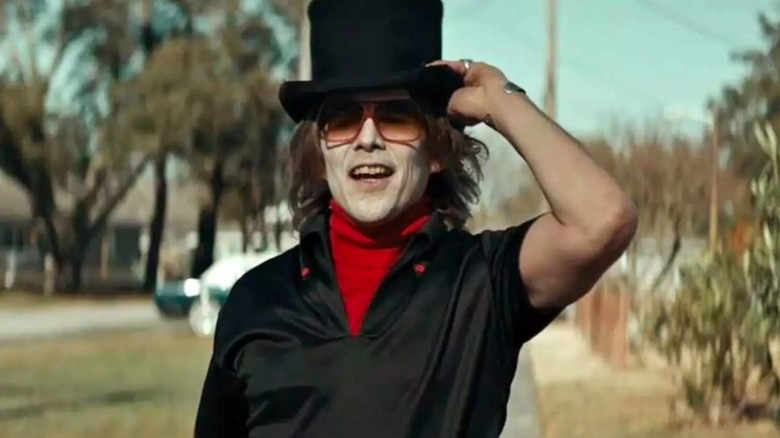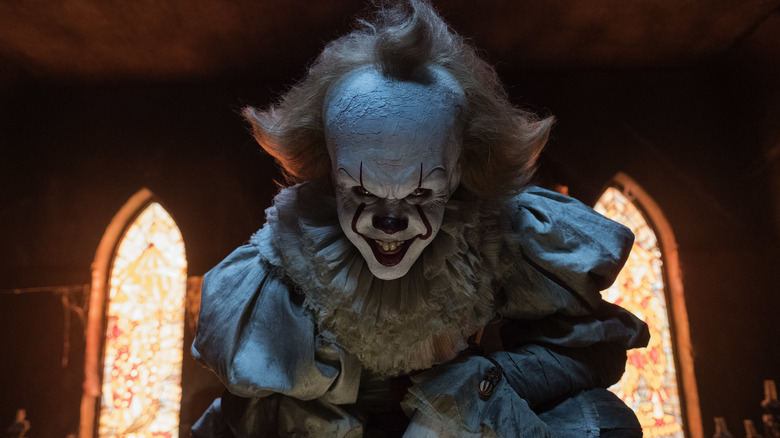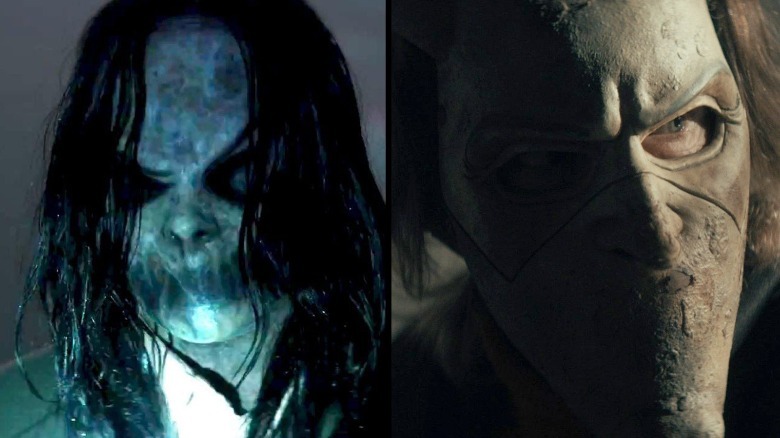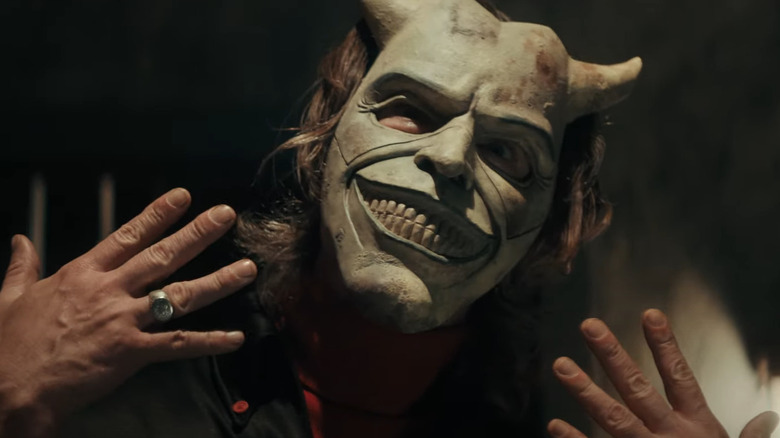The Black Phone Villain Was Originally Going To Be A Clown, But Then IT Happened
One of the scariest movie villains of 2022 so far is the Grabber (Ethan Hawke), the antagonist of Scott Derrickson's supernatural horror film "The Black Phone." The otherwise unnamed villain is a child abductor and killer, plucking kids off the streets in 1970s Colorado. The Grabber isn't onscreen for much of the movie and we learn practically nothing about him, but he's memorable thanks to two important things.
One: Hawke's terrifying performance; who would've thought that a usually reserved performer like Hawke could do a great Robert Englund? Second, the masks. Throughout the film, the Grabber wears an assortment of carved, demonic masks. The upper half of the mask bears horns and eye holes, while the lower halves alternate from a smile to a scowl to no mouth at all.
Even more impressive, these creepy masks actually came about as a result of a change from the source material. In the original short story by Joe Hill, the Grabber is described as "a fat man" who introduces himself to Finney as a "part-time clown" in order to explain the black balloons in the back of his van, and he doesn't wear a mask in his interactions with his victims. However, after Andy Muschietti's adaptation of "IT" beat "The Black Phone" to the punch in featuring a demonic clown, director Scott Derrickson and screenwriter C. Robert Cargill were urged to change the Grabber's occupation.
Joe Hill's concerns
In case you didn't know, "The Black Phone" author Joe Hill is the son of Stephen King. Hill has always been conscious about living in his father's shadow, as is clear from his pen name (short for his middle name, Hillström). That's why when he was reading Scott Derrickson and C. Robert Cargill's script for "The Black Phone," he had one request for a change.
When the Grabber abducts the film's hero Finney (Mason Thames), he's dressed like a magician, but the original script stuck with the short story's angle of the Grabber being a "part-time clown." In an interview with ScreenRant, Hill explained that his one major creative input on the movie was reimagining the Grabber as a magician rather than a clown:
"I read the script and, I can't remember if 'IT' had come out at that point or was just about to come out, and I said, 'Guys, I don't think he can be a part-time clown, not with Pennywise about to explode on the American consciousness. I just think there's room for only one deadly clown. So what if we made him a part-time magician instead?'"
Hill explained that his inspiration for the change was stage magician acts of the early 20th century when a single magician would act both as the devil performing witchcraft and as a heroic magician fighting back. With the seed of that idea planted, special effects team Tom Savini and Jason Baker designed the creepy masks that became a centerpiece of the film.
Hill compared the mask to Michael Myers from "Halloween," but another apt comparison would be Bughuul, the demonic villain of Derrickson's 2012 film "Sinister." Compare Bughuul's face to the Grabber's mouthless mask and see for yourself.
Another reason this was the right call
C. Robert Cargill also recounted the story of the Grabber's redesign to the Hollywood Reporter. In both interviews, Hill and Cargill name-check John Wayne Gacy as an inspiration for the Grabber. Gacy was a pedophile and serial killer who killed at least 33 boys during the 1970s. In his day job he performed at children's events as a clown named "Pogo" or "Patches." The influence of his crimes on the Grabber's character could not be more obvious.
However, as /Film's BJ Colangelo has argued, decoupling the Grabber from Gacy was the right call. It allows the story to stand on its own, for one, and avoids any queer fear-mongering subtext to the villain's characterization. The script describes the Grabber as having once been locked in the cellar where he keeps his victims. His goal is for them to escape so he can beat them with a belt, a sadistic game he calls "Naughty Boy." His crimes aren't driven by pedophilia like Gacy's were; they're about recreating his own childhood abuse, with himself in control.
Plus, on an aesthetic level, it's hard to picture a clown mask being as terrifying as the Grabber's demonic visages. The Grabber's final design is unique and eye-catching, while a clown mask would not only be too similar to Pennywise, but also a poor fit for the grimy aesthetic of "The Black Phone."
Clowns are plenty scary, but the devil is scarier still.



